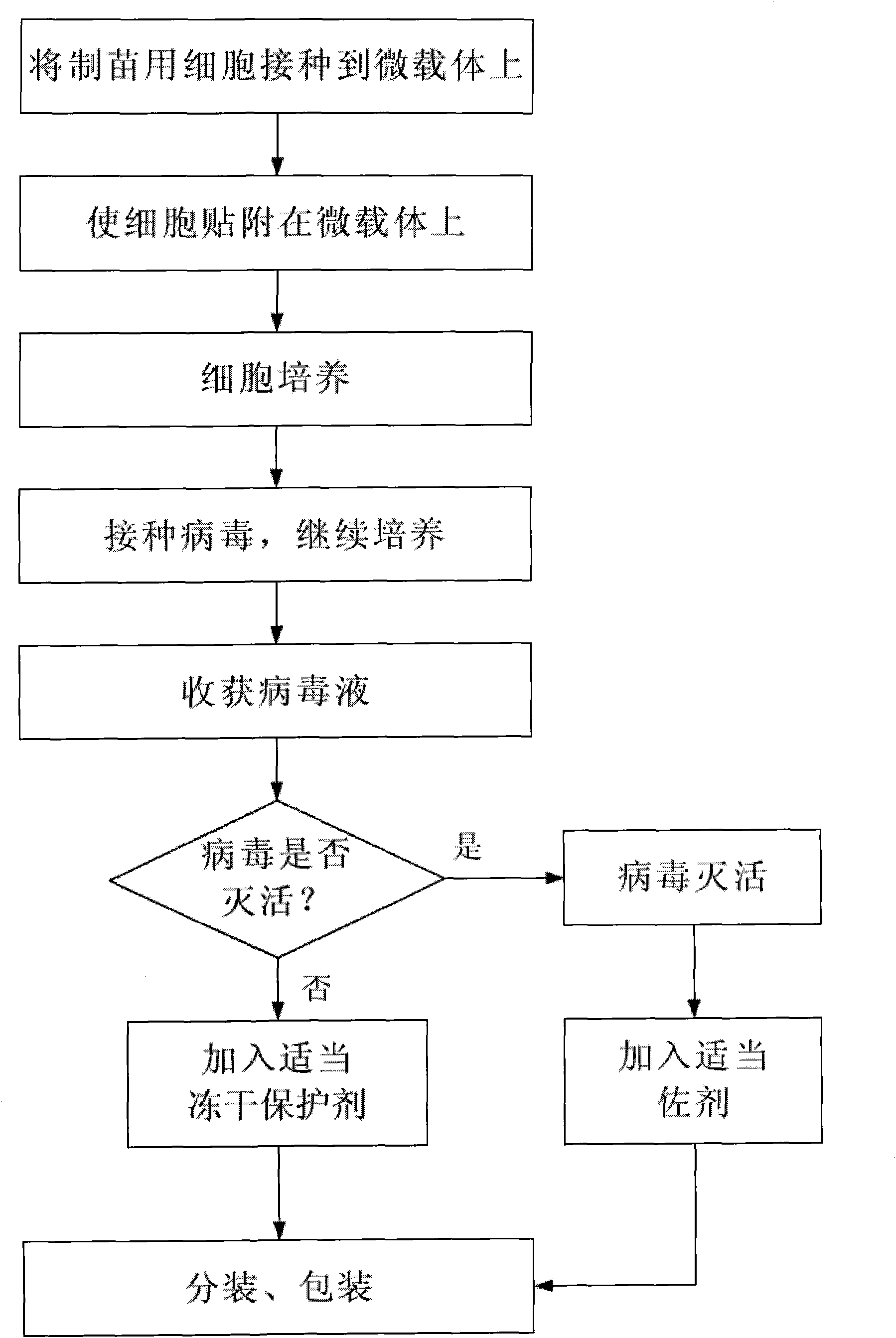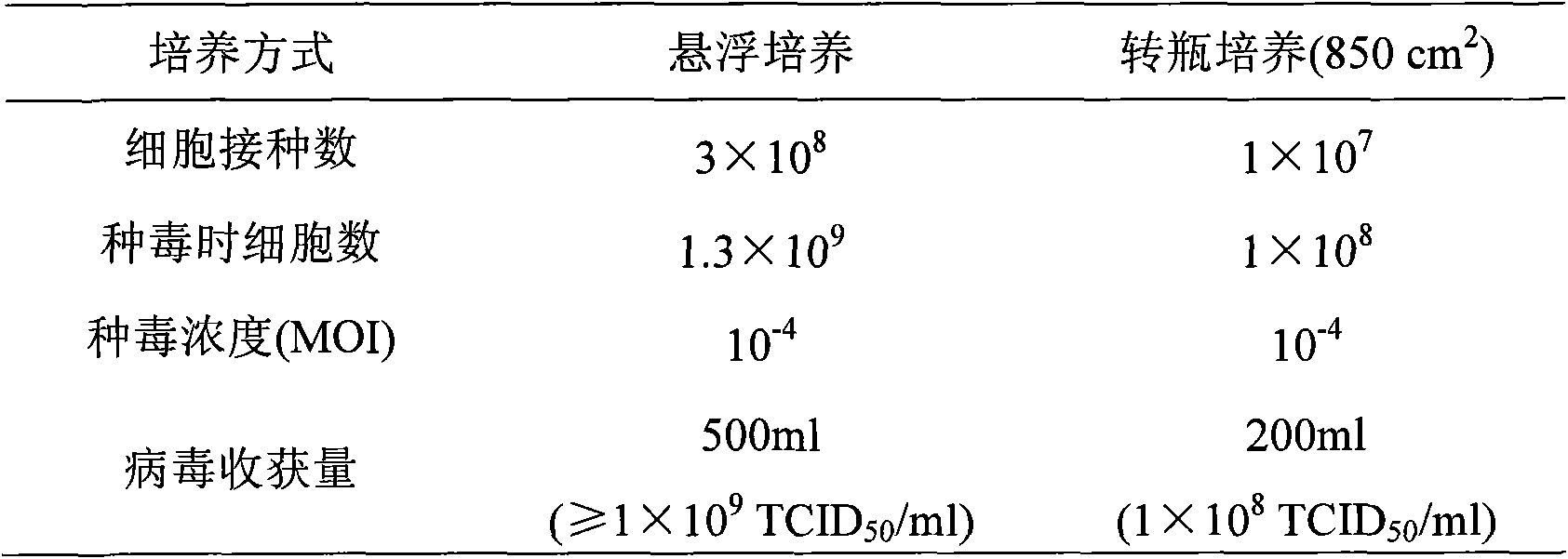Vaccine produced by suspended microcarrier cell culture system and method for producing vaccine
A cell culture and microcarrier technology, applied in microorganism-based methods, biochemical equipment and methods, microorganisms, etc., can solve the huge cost of space and equipment use and maintenance, increase the burden of human labor costs, and cannot culture cells in large quantities at one time, etc. problems, to achieve the effect of saving costs and manpower, easy control, and high production efficiency
- Summary
- Abstract
- Description
- Claims
- Application Information
AI Technical Summary
Problems solved by technology
Method used
Image
Examples
Embodiment 1
[0030] The making of embodiment 1 bird flu live virus vaccine
[0031] 1.1 Viruses and cell lines
[0032] The virus used to make avian influenza vaccine must be provided by a government-authorized unit. It is the H5N1 reassortant vaccine prototype strain (reassortant), which is isolated from a highly pathogenic avian influenza virus strain (for example: A / Hong Kong / 213 / 2003 or A / VietNam / 1194 / 2004, or NIBRG-14). After the pathogenicity test, the results show that the H5N1 reassortment vaccine prototype strain virus is not pathogenic before it can be used to make H5N1 avian influenza vaccine. In addition, a cell line with good susceptibility to the virus strain (the dog kidney cell line Madin Darby Canine Kidney, MDCK was used in this embodiment) was used as the cell line for seedling production to infect and multiply the H5N1 avian influenza virus in large quantities.
[0033] Cell lines, seed strains, and virus strains for mass production are all in accordance with the pro...
Embodiment 2
[0052] 2.1 Preparation of porcine pseudorabies live virus vaccine
[0053] 2.1.1 Viruses and cell lines
[0054] The virus used to make the porcine pseudorabies live virus vaccine is obtained by removing the gI glycoprotein and thymidine kinase (TK) double genes on the virulent strain (LC) of pseudorabies virus (Pseudorabies virus, PRV) by genetic engineering. Attenuated strains with gene defects. After the pathogenicity test, the result shows that gI glycoprotein and thymidine kinase (TK) double gene defect attenuated strain (LCM strain) virus has no pathogenicity, and it can be used to make porcine pseudorabies live virus vaccine. And use the cell line that has good susceptibility to this virus strain (the present embodiment selects hamster young mouse kidney cell BHK cell for use; Other cells such as: rabbit kidney cell (PK13) or African green monkey kidney cell (VERO) are also to swine pseudorabies Porcine pseudorabies virus has good susceptibility), as a cell line for s...
Embodiment 3
[0110] 3.1 Production of live Japanese encephalitis vaccine
[0111] 3.1.1 Viruses and cell lines
[0112] The virus used to make Japanese encephalitis live virus vaccine is the "at" strain, which is collected from pigs infected with Japanese encephalitis and passed 220 generations on hamster kidney cells (HK cells) to become Attenuated strain. After the pathogenicity test, the results show that the attenuated strain of the virus is not pathogenic before it can be used to make Japanese encephalitis live virus vaccine. And use the cell line that this virus strain has good susceptibility (the present embodiment selects hamster kidney cell (HK); Other cells such as: pig kidney cell (PK) and African green monkey kidney cell (VERO) are also to Japanese encephalitis virus have good susceptibility), as a cell line for making seedlings, by infecting and multiplying Japanese encephalitis virus in large quantities.
[0113] 3.1.2 Method
[0114] (1) Inoculate HK cells for seedling p...
PUM
 Login to View More
Login to View More Abstract
Description
Claims
Application Information
 Login to View More
Login to View More - R&D
- Intellectual Property
- Life Sciences
- Materials
- Tech Scout
- Unparalleled Data Quality
- Higher Quality Content
- 60% Fewer Hallucinations
Browse by: Latest US Patents, China's latest patents, Technical Efficacy Thesaurus, Application Domain, Technology Topic, Popular Technical Reports.
© 2025 PatSnap. All rights reserved.Legal|Privacy policy|Modern Slavery Act Transparency Statement|Sitemap|About US| Contact US: help@patsnap.com



